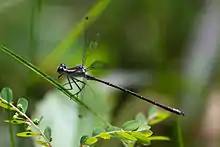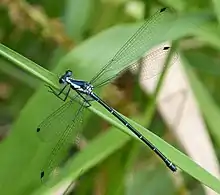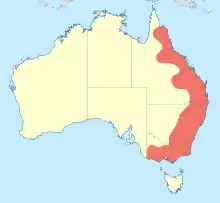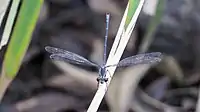Common flatwing
The common flatwing (Austroargiolestes icteromelas) is a very common species of damselfly of the subfamily Argiolestinae in the family Megapodagrionidae.[3][4] It is also known as an Australian flatwing.
| Common flatwing | |
|---|---|
 | |
| Male | |
 | |
| Female | |
| Scientific classification | |
| Kingdom: | Animalia |
| Phylum: | Arthropoda |
| Class: | Insecta |
| Order: | Odonata |
| Suborder: | Zygoptera |
| Family: | Megapodagrionidae |
| Genus: | Austroargiolestes |
| Species: | A. icteromelas |
| Binomial name | |
| Austroargiolestes icteromelas | |
 | |
Both male and female common flatwings look similar, with a long and slender body about 43 mm in length, and a bright metallic-blue colour. They usually rest with their wings flat open, but females sometimes rest with wings folded up. Their antennae are very small, and their compound eyes are comparatively large. Common flatwings do not use their legs for walking, but for capturing other flying insects in the air, like all other dragonflies and damselflies. They can be found along streams and creeks, are seldom found near still water ponds, but are more likely to be found near slow running water. This species likes to rest within a few metres of a creek or stream, in a shaded area, sometimes resting in large groups among plants. They perch on leaves and, when disturbed, fly a short distance. Common flatwings tolerate people close to them.
Subspecies
Austroargiolestes icteromelas has a two subspecies: Austroargiolestes icteromelas icteromelas and Austroargiolestes icteromelas nigrolabiatus.
Distribution
The common flatwing is found in eastern Australia: in Australian Capital Territory, New South Wales, Queensland, and Victoria.
Gallery
 Male
Male.jpg.webp) Male
Male.jpg.webp) Austroargiolestes icteromelas nigrolabiatus in Brisbane
Austroargiolestes icteromelas nigrolabiatus in Brisbane.jpg.webp) Tip of female tail
Tip of female tail.jpg.webp) Tip of male tail
Tip of male tail.jpg.webp) Female wings
Female wings.jpg.webp) Male wings
Male wings
References
- Dow, R.A. (2017). "Austroargiolestes icteromelas". IUCN Red List of Threatened Species. 2017: e.T87531977A87534001. doi:10.2305/IUCN.UK.2017-1.RLTS.T87531977A87534001.en.
- Selys-Longchamps, E. (1862). "Synopsis des Agrionines, troisième légion: Podagrion". Bulletin de la Classe des Science, Académie Royale de Belgique. 2. 14: 5–44 [40].
- "Species Austroargiolestes icteromelas (Selys, 1862)". Australian Faunal Directory. Australian Biological Resources Study. 2012. Retrieved 12 January 2020.
- Theischinger, Günther; Hawking, John (2006). The Complete Field Guide to Dragonflies of Australia. Collingwood, Victoria, Australia: CSIRO Publishing. p. 52. ISBN 978 0 64309 073 6.
External links
 Media related to Austroargiolestes icteromelas at Wikimedia Commons
Media related to Austroargiolestes icteromelas at Wikimedia Commons- Brisbane Insects
